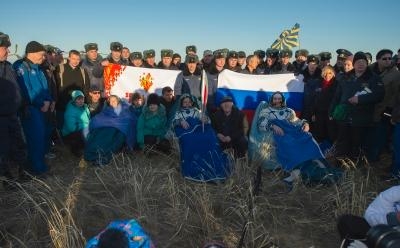Tue, Nov 12, 2013
Expedition 37 Crew Lands In Kazakhstan After 166 Days in Space
Expedition 37 crew members Karen Nyberg of NASA, Fyodor Yurchikhin of the Russian Federal Space Agency and Luca Parmitano of the European Space Agency have returned to Earth from the International Space Station, landing at 2149 EST Sunday, Nov. 10 (8:49 a.m. Kazakhstan time, Nov. 11), after spending 166 days in space.

Inside the Soyuz spacecraft carrying the astronauts was the Olympic torch, which was launched to the station Nov. 6 and taken on a spacewalk Saturday as part of the torch relay. The torch will be used to light the Olympic flame at the Fisht Stadium in Sochi, Russia, marking the start of the 2014 Winter Games in February.
Nyberg, Parmitano and Yurchikhin arrived at the station in May, and during their extended stay in space orbited Earth 2,656 times and traveled more than 70 million miles. Parmitano conducted a spacewalk in July, becoming the first Italian to walk in space. The crew welcomed Orbital Sciences Corp.'s Cygnus cargo spacecraft during its demonstration mission to the station. The trio spent hundreds of hours conducting fundamental research in areas such as human biology, life sciences, physical sciences, Earth sciences, astrophysics and technology research.
Yurchikhin now has logged 537 days in space, spanning four spaceflights. This puts him 12th on the all-time endurance list. Nyberg has accumulated 180 days in space over two missions. This was Parmitano's first mission.
The crew performed research into how plants grow, which may lead to more efficient crops on Earth and improve understanding of how future crews could grow their own food in space. They tested a new portable gas monitor designed to help analyze the environment inside the space station and continued fuel and combustion experiments undertaken by past crews. The crew also collected data and samples that will be used to help scientists understand ocular health issues of space station crew members and understand changes to body measurements during spaceflight.
More News
Outboard Section Of The Right Wing And The Right Flap Separated In Flight And The Airplane Impacted A Farm Field Analysis: The pilot was approaching his destination airport under i>[...]
Final Approach Fix The fix from which the final approach (IFR) to an airport is executed and which identifies the beginning of the final approach segment. It is designated on Gover>[...]
"Our choice of when to respond, how to respond and on which targets to respond is a consideration that we make every time... Netanyahu also noted that anyone attacking Israel &ldqu>[...]
Estimated (EST) When used in NOTAMs “EST” is a contraction that is used by the issuing authority only when the condition is expected to return to service prior to the e>[...]
Aero Linx: Coalition of Airline Pilots Associations (CAPA) The Coalition of Airline Pilots Associations (CAPA) is the world’s largest pilot trade association representing ove>[...]
 NTSB Final Report: Cessna 177B
NTSB Final Report: Cessna 177B ANN's Daily Aero-Term (05.08.25): Final Approach Fix
ANN's Daily Aero-Term (05.08.25): Final Approach Fix Aero-News: Quote of the Day (05.08.25)
Aero-News: Quote of the Day (05.08.25) ANN's Daily Aero-Term (05.09.25): Estimated (EST)
ANN's Daily Aero-Term (05.09.25): Estimated (EST) ANN's Daily Aero-Linx (05.09.25)
ANN's Daily Aero-Linx (05.09.25)



